Poly(A) at the 3' end of positive-strand RNA and VPg-linked poly(U) at the 5' end of negative-strand RNA are reciprocal templates during replication of poliovirus RNA
- PMID: 20071574
- PMCID: PMC2826026
- DOI: 10.1128/JVI.02620-08
Poly(A) at the 3' end of positive-strand RNA and VPg-linked poly(U) at the 5' end of negative-strand RNA are reciprocal templates during replication of poliovirus RNA
Abstract
A 3' poly(A) tail is a common feature of picornavirus RNA genomes and the RNA genomes of many other positive-strand RNA viruses. We examined the manner in which the homopolymeric poly(A) and poly(U) portions of poliovirus (PV) positive- and negative-strand RNAs were used as reciprocal templates during RNA replication. Poly(A) sequences at the 3' end of viral positive-strand RNA were transcribed into VPg-linked poly(U) products at the 5' end of negative-strand RNA during PV RNA replication. Subsequently, VPg-linked poly(U) sequences at the 5' ends of negative-strand RNA templates were transcribed into poly(A) sequences at the 3' ends of positive-strand RNAs. The homopolymeric poly(A) and poly(U) portions of PV RNA products of replication were heterogeneous in length and frequently longer than the corresponding homopolymeric sequences of the respective viral RNA templates. The data support a model of PV RNA replication wherein reiterative transcription of homopolymeric templates ensures the synthesis of long 3' poly(A) tails on progeny RNA genomes.
Figures
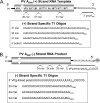
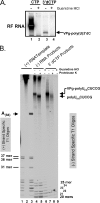
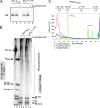
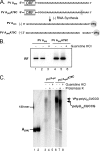
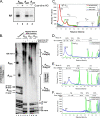

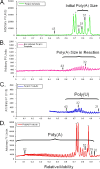
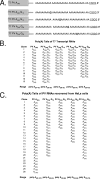

Similar articles
-
Poliovirus CRE-dependent VPg uridylylation is required for positive-strand RNA synthesis but not for negative-strand RNA synthesis.J Virol. 2003 Apr;77(8):4739-50. doi: 10.1128/jvi.77.8.4739-4750.2003. J Virol. 2003. PMID: 12663781 Free PMC article.
-
Poliovirus cre(2C)-dependent synthesis of VPgpUpU is required for positive- but not negative-strand RNA synthesis.J Virol. 2003 May;77(9):5136-44. doi: 10.1128/jvi.77.9.5136-5144.2003. J Virol. 2003. PMID: 12692216 Free PMC article.
-
Functional dissection of a poliovirus cis-acting replication element [PV-cre(2C)]: analysis of single- and dual-cre viral genomes and proteins that bind specifically to PV-cre RNA.J Virol. 2003 May;77(9):5152-66. doi: 10.1128/jvi.77.9.5152-5166.2003. J Virol. 2003. PMID: 12692218 Free PMC article.
-
Mechanistic intersections between picornavirus translation and RNA replication.Adv Virus Res. 2011;80:1-24. doi: 10.1016/B978-0-12-385987-7.00001-4. Adv Virus Res. 2011. PMID: 21762819 Review.
-
Uridylylation of the genome-linked protein of poliovirus in vitro is dependent upon an endogenous RNA template.Virus Res. 1987 Sep;8(3):193-204. doi: 10.1016/0168-1702(87)90015-3. Virus Res. 1987. PMID: 2825442 Review.
Cited by
-
Caspase-8 and FLIP regulate RIG-I/MDA5-induced innate immune host responses to picornaviruses.Future Virol. 2012 Dec;7(12):1221-1236. doi: 10.2217/fvl.12.115. Future Virol. 2012. PMID: 23503762 Free PMC article.
-
Three Poliovirus Sequences in the Human Genome Associated With Colorectal Cancer.Cancer Genomics Proteomics. 2019 Jan-Feb;16(1):65-70. doi: 10.21873/cgp.20112. Cancer Genomics Proteomics. 2019. PMID: 30587500 Free PMC article.
-
Structural features of a picornavirus polymerase involved in the polyadenylation of viral RNA.J Virol. 2013 May;87(10):5629-44. doi: 10.1128/JVI.02590-12. Epub 2013 Mar 6. J Virol. 2013. PMID: 23468507 Free PMC article.
-
Multiple functions of the nonstructural protein 3D in picornavirus infection.Front Immunol. 2024 Apr 2;15:1365521. doi: 10.3389/fimmu.2024.1365521. eCollection 2024. Front Immunol. 2024. PMID: 38629064 Free PMC article. Review.
-
Propensity of a picornavirus polymerase to slip on potyvirus-derived transcriptional slippage sites.J Gen Virol. 2019 Feb;100(2):199-205. doi: 10.1099/jgv.0.001189. Epub 2018 Dec 3. J Gen Virol. 2019. PMID: 30507373 Free PMC article.
References
-
- Baltimore, D., Y. Becker, and J. E. Darnell. 1964. Virus-specific double-stranded RNA in poliovirus-infected cells. Science 143:1034-1036. - PubMed
Publication types
MeSH terms
Substances
Grants and funding
LinkOut - more resources
Full Text Sources

